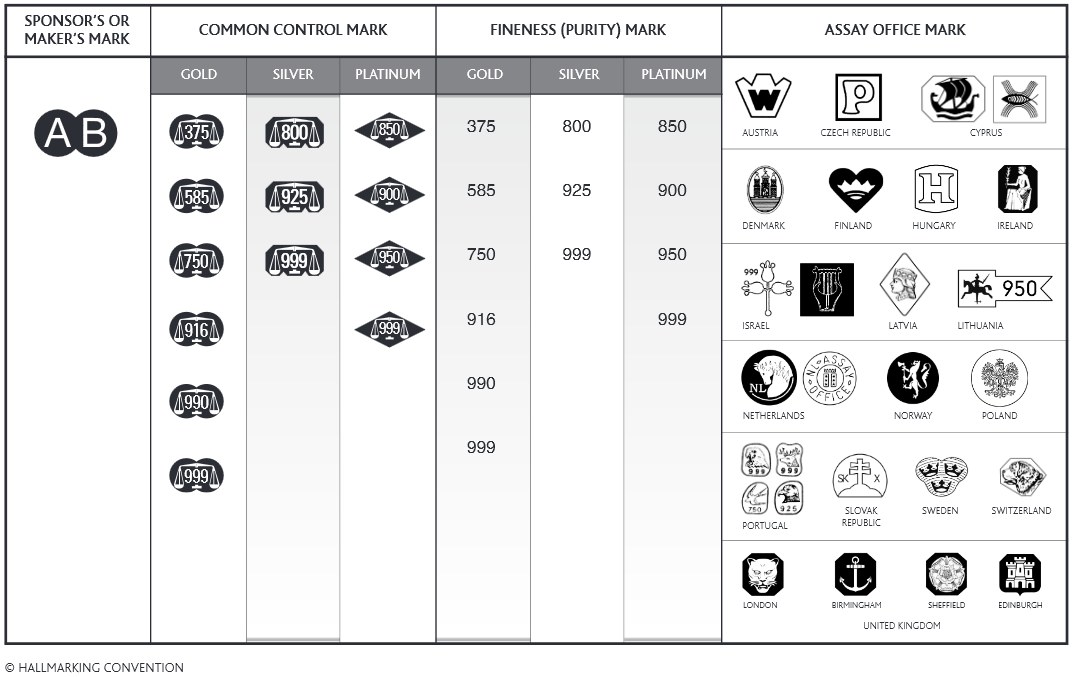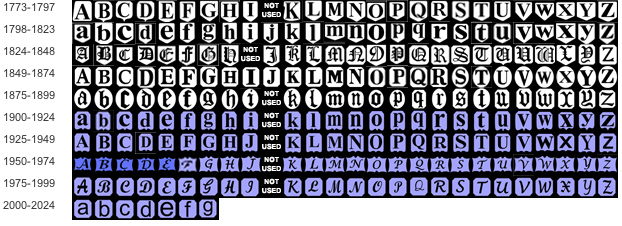Common Hallmarks
 This List thanks to http://www.theiaao.com
This List thanks to http://www.theiaao.com
Precious metals are very soft when in their pure form. Other elements are added to them to create alloys which have improved mechanical properties, making them useful for everyday items such as jewellery and silverware. Usually it is impossible to tell how much of the pure metal is in the alloy by visual appearance, weight or touch.
Hallmarks are marks applied to precious metals to indicate the amount of pure metal in the alloy. Traditionally applied by striking with a punch, hallmarks can now also be applied using lasers.
The term hallmarking dates back to 1478 when goldsmiths and silversmiths had to send their wares to Goldsmiths’ Hall in London to be marked. However, the concept of marking precious metals to show their purity predates this by well over a century. This rich history has made hallmarking not only one of the oldest and most successful forms of consumer protection but has also been an invaluable tool in the detection of fakes. The hallmark has become widely used to add value to items and offers a wide range of marketing possibilities.
These days, hallmarking is carried out by assay offices which are situated in many countries over the world, but are most prevalent in Europe, the Middle-East and Asia. In some countries, assay offices are operated by the state and in others they are run as private operations. Some countries operate compulsory systems, others operate voluntary systems. The vast majority, but not all offices, are independent of the customers they serve.
While each state has its own particular rules for hallmarking, most hallmarks comprise the following marks:
A Sponsor’s Mark (often also termed a Responsibility Mark or Maker’s Mark), indicating who was responsible for sending the item to be hallmarked.
- An Assay Office Mark, indicating which assay office marked the item.
- A Fineness (purity) Mark, indicating the precious metal content of the article and that it is not less than the fineness of the article indicated. The fineness is often indicated by a millesimal number (parts per thousand) and the metal type is indicated by the shape of the surround. Sometimes the Assay Office Mark and Fineness Mark are combined into a single mark.
Other marks may be seen, such as Date Letters, Commemorative Marks to indicate special occasions and symbols which were used historically to represent different purities.
The Convention on the Control and Marking of Articles of Precious Metals (shortened to the Hallmarking or Vienna Convention) was signed in Vienna in November 1972. This was an agreement between states to permit mutual recognition of hallmarks. This allowed items marked in one country with what was termed a Convention Hallmark to be sold in another signatory country without the need for re-hallmarking. The Convention Mark essentially comprises a National Hallmark with an additional mark called a Common Control Mark added.
A typical examples of a Hallmark and a Convention Hallmark is shown below:
UK National Hallmark
Order of marks: Sponsor’s Mark, Lion Passant (the traditional symbol for sterling silver), Fineness Mark for sterling silver (92.5% silver), Leopard’s Head (the symbol for the London Assay Office), Date Letter

UK Convention Mark
Order of marks: Sponsor’s Mark, Common Control Mark, Finenes Mark for sterling silver (92.5% silver), Leopard’s Head (the symbol for the London Assay Office)

Date Letters 1773 to 2010
| The date letters below show the background shape for silver. The same letters were used for Gold, which has been marked in Birmingham since 1824, but with a background of a square with cut corners. There may be some variations in backgrounds during the late 19th century, especially on watch cases.
In Birmingham the date letter changes in July up to 1974. From 1975, all Assay offices have the same date letter. Gold was marked in Birmingham from 1824. The date letters for gold are on the background. |
||||||
|
More Marks and Date Letters
 |
Lion Passant |
|
 |
Britannia |
For information on more recent standard marks, please visit The Assay Office
 |
The mark of the sovereign's head does not appear in all hallmarks, but if it does, it will tell you that the item was marked during a year when duty was levied on gold and silver by the Crown. Duty marks will appear on items marked at The Birmingham Assay Office from 1784 until 1890. The outlines of these marks may vary; for example, the first duty mark for George III, used between 1784 and 1786, sometimes appears with a trefoil outline. The double duty mark for 1797 was only used briefly during that year when the duty was doubled. The duty mark for a new monarch could be introduced a year or two late and at any time of the year. For example, a Birmingham hallmark for 1838 can have either the duty mark for William IV or Victoria. Likewise, the old punches were often used for some time after each sovereign's death. |
|||||
For American marks try here - http://www.925-1000.com/americansilver__Menu.html
For British marks try here - http://www.925-1000.com/british_marks.html
Copyright © www.VintageAntiqueRetro.com 2012 - 2016 | Terms | Sitemap | Faq | Contact Us | Web Development by Kevin Northcott





